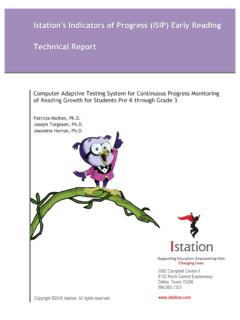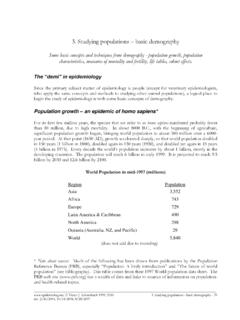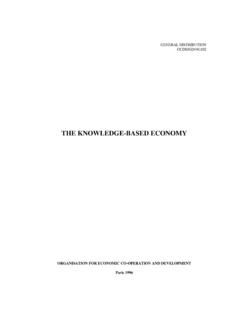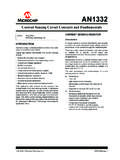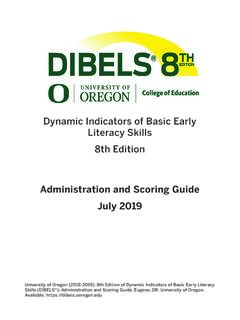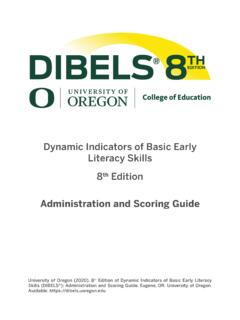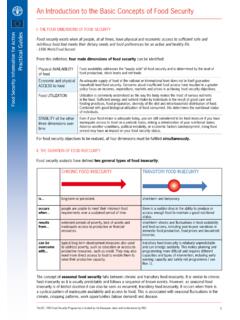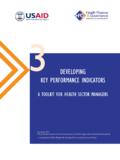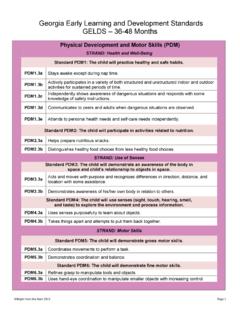Transcription of Measuring Tourism: Methods, Indicators, and Needs
1 Measuring Tourism: Methods, Indicators, and Needs R. Baggio In: Cooper, C. and Fayos Sol , The Future of Tourism: Innovation and Sustainability, Heidelberg: Springer, 2018 =*=*=*=*= Abstract This contribution examines the wicked problem of adequately Measuring tourism in its many facets. This concise survey examines the main techniques used today for assessing tourism flows and their direct, indirect, and induced effects on environmental, socio cultural, and economic macro scenarios. Demand and supply evaluations are explored through the description of traditional time series and econometric models and the main national tourism statistical measurements together with cutting edge techniques such as the artificial intelligence methods that use the most recent advances in computer science. The important task of estimating the impacts of tourism related activities on the socio economic environment is discussed by looking at the most popular methods such as the Input Output model, the Social Accounting Matrix, the Computable General Equilibrium model and the Tourism Satellite Account.
2 Moreover, computerised numerical simulation techniques are called into play for their capability to provide useful insights and outcomes in complex and uncertain situations, typical of the tourism domain. The analysis discusses the main shortcomings of all these approaches. In an increasingly complicated and fast changing World, many of the foundations up to now considered relatively set have seen, in recent times, a number of disruptive modifications. As a consequence our traditional approaches have lost most of their validity and seem no more fully able to provide useful and reliable insights. Methodological and instrumental changes are sketched as a possible answer to the question. Keywords tourism measurement, demand supply, impact of tourism, quantitative methods, numerical simulations, artificial intelligence Introduction Tourism is, we all know, a complex phenomenon. Actually tourism is a blanket term under which we strive to include an incredible number of entities, behaviours, activities, sectors or subjects, all more or less related to the movement of people across places or countries.
3 The so many diverse elements that are commonly grouped in the concept even raise the question as to whether or not tourism is, in fact, too varied and chaotic to deserve separate consideration as a subject or economic sector (Cooper et al., 2008: 5). Despite this complexity, a wealth of actions, strategies, policies , at local or global level, depend on some kind of measurement of the phenomenon or of its effects. Now, whenever an action is needed or wanted that concern a phenomenon or a system, our cultural tradition call for the need of a definition of the object and some measurement of its characteristics and evolution in time. This is what we mean by scientific approach (Andersen & Hepburn, 2016). When tourism comes into play, however, we have to consider several difficulties that come, essentially, from the fact that we deal with complex adaptive systems. The complexity derives not much from the number or diversity of the items we consider, but rather from the characteristics of the phenomenon and its associated systems.
4 , that are relatively easy to recognise. They consist, essentially, of the presence of a certain (large) number of components of different nature that have often non trivial relationships between them and with the external environment, and whose evolution (individually and as a group) is highly sensitive to the initial conditions. This gives rise to what are called emergent phenomena, that is events or configurations that cannot be easily inferred from the individual characteristics of the components that, in a way, come out almost as a surprise and can be only foreseen by using simulation techniques. Moreover the system has a memory or includes feedback loops that allow it to adapt itself in accordance with its history or feedback (Johnson, 2009). As many scholars have shown, these are common features of all tourism systems and manifestations (Baggio, 2008; Baggio & Sainaghi, 2011; Farrell & Twining Ward, 2004; Faulkner & Russell, 1997). One of the main consequences of having to deal with complex systems is the claimed inherent unpredictability of the system s dynamics (Boffetta et al.)
5 , 2002). However, never declared but implicitly assumed in almost all forecast works, a common hypothesis is that all systems exhibit some kind of inertia which drives them along a temporarily stable evolutionary path. This means that while correct long term predictions are impracticable, with the limitation of not extending a forecast too far in time, we may still use the methods devised so far to attempt a forecast (Andersen & Sornette, 2005; DelSole & Tippett, 2009). In this chapter we examine the most common methods used in the tourism domain for Measuring its aspects and impacts (mainly economic) and discuss their limitations as a requisite for future improvements and refinements. Measuring tourism: The problem of defining what you want to measure There is a widespread conviction that managing, governing, controlling or simply understanding phenomena, firms, countries or individuals cannot be achieved without some kind of quantitative measurement, especially since our socio economic environment has become heavily performance oriented.
6 In tourism this translates into the need of unified data driven bases for making decisions, designing plans and strategies, be accountable of the investments made. Whether real objects or abstract models, an obvious prerequisite for the measurability is the possibility to define the object of study or at least to frame it by delimiting what we want to measure. In many cases (especially psychology or social sciences) this is not possible, therefore we resort to an operationalisation process that allows expressing fuzzy or ill defined concepts so that they become measurable and understandable in terms of empirical observations. Then, the act of Measuring essentially consist of the assignment of a number to a certain feature, object or event so that it can be compared with others (Nagel, 1931; Stevens, 1946). Modern measurement theory calls for two important characteristics: accuracy, the absence of systematic errors, and precision, the smallness of random measurement errors.
7 In other words measurements are accurate if they are close to the true value of what we measure, and precise if all measurements of a quantity are close to each other (Tal, 2016). Defining tourism is a complicated matter. Actually, as well known, the discussion on what is tourism? and on what elements should be considered as belonging to this domain is quite old and many works have been devoted to the analysis of the problem. Practically any book on the subject start with a chapter in which it is possible to find some discussion on these difficulties followed by what a scientist would call an operational definition. The fact is that a formal conceptual definition does not exist, and probably will never exist, so we need to resort to something that can allow some kind of practical treatment, mainly for what concerns the decision on what to consider and therefore measure. This is the case of one of the most used approach, that of the UNWTO which defines tourism as comprising: the activities of persons travelling to and staying in places outside their usual environment for not more than one consecutive year for leisure, business and other purposes not related to the exercise of an activity remunerated from within the place visited.
8 (UNStats, 2008b: 1) Even in this case, however, the fuzziness of the terms used poses a number of issues for an accurate and precise measurement of the phenomenon, for what attains to both the tourists and the entities that provide products and services (that which many call the industry ). In the latter case, for example, not having a common, shared and agreed, delimitation generates an incredible and often non compatible variety of classifications, so that, practically, no country has been able to clearly and fully define what elements (companies, groups, services, products) belong to the tourism sector and no easy way of Measuring the activities exist. However, even in this situation many methods have been devised for assessing the extent and the impacts of tourism in a geographically (or administratively) defined area. Current methods and main issues Given tourism s economic importance, it looks natural to adopt an economic terminology and reason in terms of supply and demand.
9 Demand is made of all those travelling to some place (tourists and destination). It can be measured by taking into account four elements: people (tourists), money (expenditure, receipts), time (stays and travels durations) and space (distances, lengths of trips) (Song et al., 2010). The first two classes of measurements are by far the most common. Despite the efforts of many national and international organisations (see the recommendations by the UN statistical division, the UNWTO or the European statistical office: (EUROSTAT, 2014; UNStats, 2008a), though, sources and collection methods for demand data differ, often substantially, across countries. Data come often from border counts (police, immigration), supplemented by surveys at entry points (airports, ports); in other cases measurements are taken at tourism accommodation establishments. In some cases peculiar areas are sampled and the results extended by estimation, in other cases counts reflect an actual coverage of all the establishments.)
10 Moreover, same people may be counted several times if they travel across a country and stay at different accommodations. Finally, most of the collection procedures are performed at some local level and must then be aggregated, following the administrative hierarchy, with all the issues related to possible transcription errors, missing items or wrong assessments (Volo, 2004). It must be noted that the issues are the same for both international and domestic travels. Rather obviously, and possibly with more problems, the same can be said when expenditures are at play, both for a natural reluctance by the travellers in declaring their expenses, and for an intrinsic difficulty in distinguishing whether certain expenses are tourism related or not (Frechtling, 2006). In summary, the overall reliability, consistency, and comparability of the demand measurements, at least at a basic level, is relatively poor, and this raises a number of challenges when parallels and comparisons are made between different areas or countries, or, more importantly, when forecasts are required for making decisions or preparing plans.
